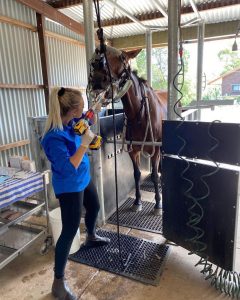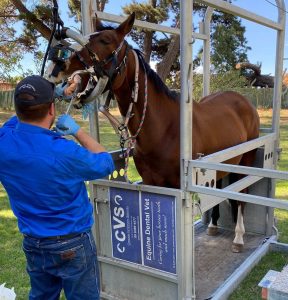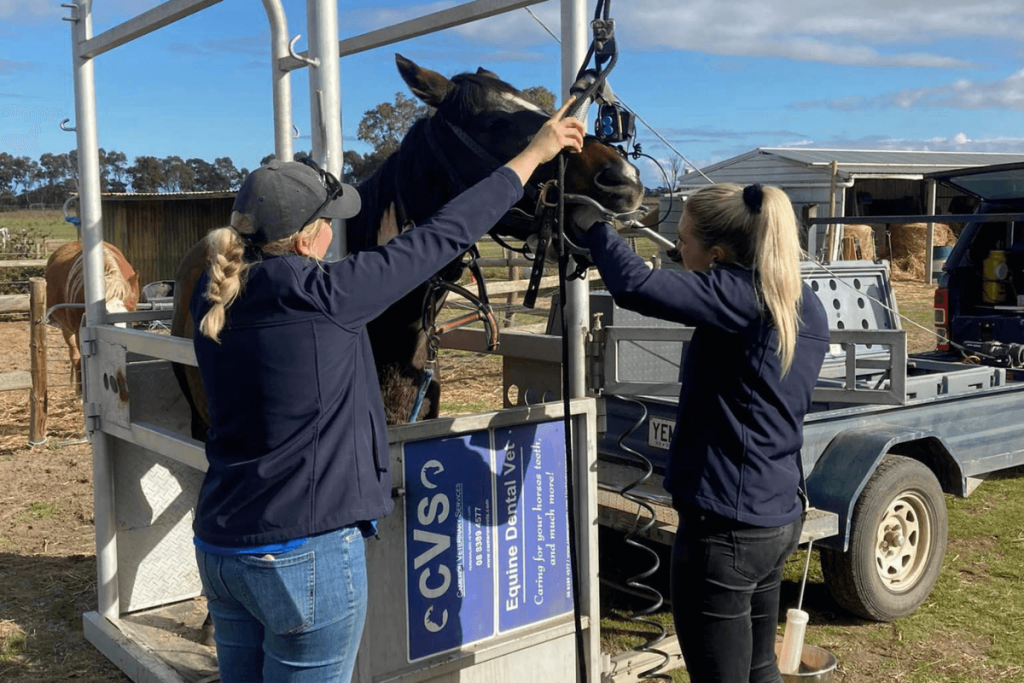Your horse’s teeth play a huge role in their overall health and comfort. Keeping a close eye on your horse’s oral health by having regular equine dental exams means your vet can detect any disease in its early stages. This results in less pain for your horse, fewer infections and a lower risk of serious health complications down the track.
Equine dental exams vs rasping teeth
There’s much more to equine dentistry than simply rasping or floating teeth. While this is an important part of looking after your horse’s teeth, it’s important to note that it’s not just irregular wear that can cause dental issues.
Some studies have shown that up to 70% of horses have undiagnosed dental problems. This makes regular dental exams vitally important to ensure any signs of dental disease or other oral health issues can be picked up and acted upon.
An equine dental exam: Step by step
So, what should you expect from an equine dental exam? Read on to find out the steps our Cameron Veterinary Services equine vets take when conducting an oral health check-up on your horse.
Step 1: Sedation
All of our dental examinations are performed under sedation. This allows for an accurate and thorough check of the horse’s teeth and mouth, both safely and efficiently. After all, how can we expect to diagnose dental conditions when the patient is moving (being a horse and all), and we simply cannot examine the mouth?
We provide your horse with a comfortable level of sedation so they’re not reacting, but we also need them alert enough to be able to look inside their mouth.
Step 2: Distance exam
Once the horse is sedated, we always start with a distance exam.
While conducting this exam, we also discuss with you, the owner, about their behaviour. For example, are they dropping food when eating, are they balling up food, are they having issues with the bit when moving in a particular direction?
We look at the horse and check for external signs of sinus infection, facial swelling or discharge out of the nasal cavity or eyes. We also look for any swelling under the jaw – this is common in younger horses as swelling can be associated with the eruption of teeth, so we are mainly looking at anything unusual or swelling of the glands.
The last step of the distance exam is to visually examine the incisors and check for any signs of overbite.
Step 3: Cleaning the mouth
Before having a closer look at your horse’s teeth, we first need to clean their mouth out thoroughly. If we can’t see their teeth properly, we can’t diagnose anything. We use a gentle stream of water via a hose to get rid of all food particles and other remnants. Sometimes it may take a few flushes to get the mouth completely clean.
During this cleaning, we also checked for any packed food, discharge or smell which may indicate periodontal disease.
Step 4: In-depth look inside the mouth
Now that the horse’s teeth are clean, we take a thorough look inside the mouth, including the teeth, tongue and whole oral cavity. We use a light and mirror to inspect all surfaces of the teeth to check for any signs of disease. This is done one arcade (or row) of teeth at a time and includes looking at the outside of the teeth, the inside and the flat surface. During this examination, we are checking for any ulcers or diseased teeth, as well as feeling for any sharp points that need to be smoothed.
Step 5: Floating

The final part of an equine dental exam is floating the teeth. As horses’ teeth continue to erupt over their lifetime, all horses will need regular floating.
We use different tools on the PowerFloat to take the sharp points off at a 45-degree angle on the outside of the horse’s teeth, before rounding out and smoothing the edges.
While a PowerFloat in action can look confronting, it gives us the ability to float the teeth much more efficiently and effectively compared to using just a rasp. Without using a PowerFloat, it is very difficult to be able to effectively smooth off the molars at the back of the mouth. We take care with the drill to minimise excessive contact with each tooth ad cool the device down regularly in water during the floating.
Step 6: Post-procedure monitoring
Once the exam and floating are complete, we check the horse’s mouth to make sure all sharp points have been curbed. We also have a vet nurse on site with us to assist with the whole procedure, and they will closely monitor your horse post-sedation until the anaesthetic has worn off.
Want to see Dr Lachie performing a routine equine dental exam? Check out this step-by-step video he recently posted on YouTube.
How often does my horse need a dental exam?

Early indications of dental disease are often very subtle, and your horse may not show any outward signs of discomfort.
Having your horses’ teeth checked regularly (at least annually) by a vet who is extensively trained in equine anatomy and physiology ensures you have a comprehensive picture of its overall dental condition, avoiding serious long-term health issues.
Here at Cameron Veterinary Services, our passion for equine dentistry is second to none. Dr Lachie and the team undertake regular equine dental training to ensure they are drawing on the latest techniques and knowledge in treating your animals.
Contact the CVS team
Did you know that we have regular dental runs across the Adelaide Plains and Gawler regions? We offer discounted travel fees if you book one of our regular travel days.
Call us today on 08 8318 1801 to book your equine dental exam.



